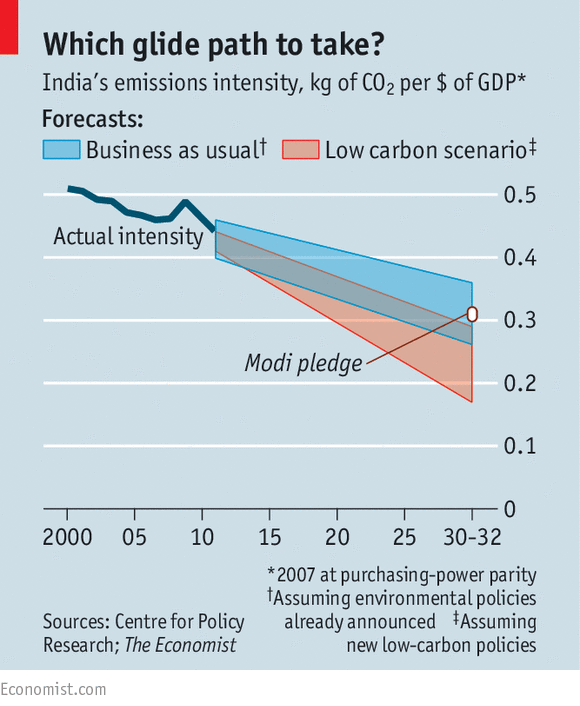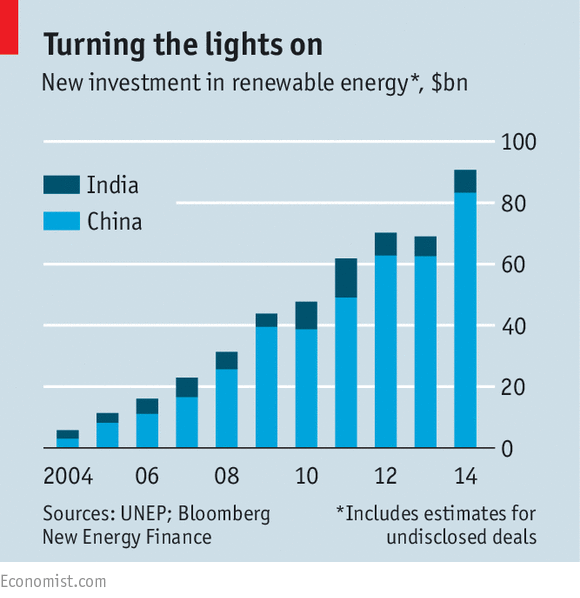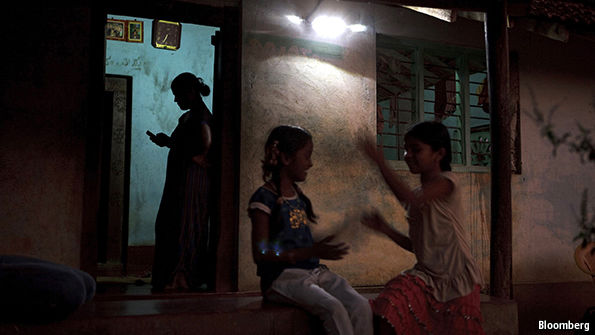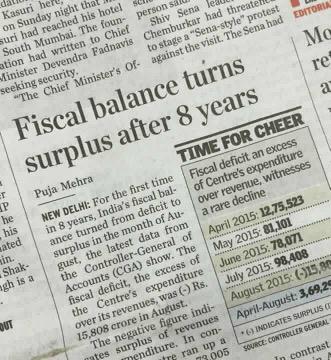Do we have a thread for climate change where I can cross post this. Very interesting analytical piece in this week's Economist.
_____________________________________________________________________________________________________________________________________________________
India and the environment
Catching up with China
The prime minister wants India to grow as fast over the next 20 years as China has over the past 20. Does that mean Chinese levels of pollution?
Oct 10th 2015 | BANGALORE | From the print edition

EVERY so often a country comes along whose economic transformation has a vast impact on the world’s climate system. For the past generation that country has been China. Next it will be India.
Given India’s size and population (1.3 billion), its emissions of carbon dioxide are in relative terms still tiny. At 1.6 tonnes of carbon per person each year, they are roughly the same as China’s per-head emissions in 1980, when that country dived into economic reforms. Now India’s prime minister, Narendra Modi, wants to emulate China’s sizzling growth. He has set India a target of expanding GDP by 8% a year. If it comes close to meeting that target, emissions will soar, just as China’s have done. Today, Chinese emissions per head are four times those in India.
Government planners think that, with economic growth of 8-9%, India’s total emissions of carbon dioxide would more than triple by 2030, from 1.7 billion tonnes in 2010 to 5.3 billion tonnes. Per-head emissions would increase to 3.6 tonnes. And that assumes a fair amount of energy savings. If India were to use the same amount of energy per unit of GDP in 2030 as it does now, then emissions would top 6 billion tonnes by 2030. India is on the way to becoming the biggest contributor to increases in greenhouse gases within 15 years—a powerful reason for caring about its progress on environmental matters.
On October 1st Mr Modi’s government filed its emissions plans in advance of a UN climate conference to take place in Paris in November. Unlike most other big countries, India refused to set a date at which the absolute amount of carbon it pumps out would peak and start to fall. Instead it promised that its carbon intensity—that is, carbon emissions per unit of GDP—would fall by a third before 2030.

By setting a relative rather than an absolute target, India has come in for criticism. That is unfair, for to cap emissions would be to deny many Indians the chance to better their hard lives. The country has more poor people than anywhere else in the world: 230m living on $1.90 a day or less—the World Bank’s definition of extreme poverty. Almost half of rural households, or 250m-300m people, have no electricity. For the poor, growth is essential—and carbon comes with it.
Yet to accept that is not to give up on curbing emissions. India has huge potential to change its trajectory. To put this in context, consider that plans announced by Barack Obama’s administration would cut American emissions by 26-28% by 2025, or just under 2 billion tonnes of carbon a year. By contrast, the difference between a good and a bad outcome in India over the same period, depending on whether good policies are adopted or not, would amount to almost 3 billion tonnes. In other words, India could do more good for the climate, as well as more harm, than most.
If there is reason to be optimistic, it is that the environment matters to Indians themselves. Thirteen of the world’s 20 most-polluted cities are in the subcontinent. Smoke from cooking with wood or dung in Indian homes may be responsible for 500,000 early deaths a year, mostly of women and children. Climate change could do grave harm to India. Some two-thirds of its agriculture depends on the monsoon, which may become less reliable as a result of global warming. Some Himalayan glaciers are retreating, sending less water to rivers that feed hundreds of millions of people downstream. A quarter of Indians live near coasts that are vulnerable to sea-level rises. Many countries suffer one or more of these problems. Few have all of them. So while Indians need growth, they cannot ignore the consequences of it.
Given the environmental pressures, gloom is not hard to find. Jairam Ramesh, environment minister in the previous Congress-led government, shakes his head as he reflects on the near-total local opposition to a plan to protect the Western Ghats, a mountain range that is one of the world’s most biologically diverse regions. “We are losing the battle of ideas,” he says. Although tree plantations are growing in India, old-growth forests are still shrinking. Pressure to cut down more trees will increase because most of India’s untapped coal reserves are underneath its forests. Coal accounts for more than half of India’s power generation—and India plans to double coal output by 2020.
As for water, another crucial environmental resource, for the moment India is one of the lucky large developing countries with adequate supplies. But according to a study in 2013 by two UN agencies, it will go from having 1,800 cubic metres of water per person per year in 2001 to only 1,340 cubic metres in 2025—and little more than 1,000 cubic metres per head by 2050, which is the international definition of water scarcity.
As if all that were not enough, Mr Modi came to power in 2014 vowing to sweep aside regulatory obstacles to growth (including, by implication, environmental regulations). He vowed to expand a manufacturing sector which, at 17% of GDP, is half the relative size of China’s. Factories pollute more than services do.
If India faces a trade-off between growth and greenery, then the only likely outcome is that growth wins. Yet it is not a simple swap. Rather, the government has multiple objectives, and this multiplicity makes pro-environment policies more likely to stick.
To see how, look at energy. The government has four main goals beyond increasing power to cities and industry. First, it wants to bring electricity to those without it. Total electricity production has risen sharply in recent years, but the number of people without power has fallen only slowly. Something needs to change.
Next, India wants to improve its energy security by buying less from abroad. At the moment, the country spends about half its foreign-exchange earnings on fuel imports, an unusually high share. Though the world’s third-largest coal producer, India imports a fifth of its coal because domestic mines cannot keep pace. And it imports four-fifths of its oil. That leaves the country vulnerable to oil shocks, even if right now it is a beneficiary of cheaper supplies.
Third, with 10m-12m young Indians entering the labour market each year, the country needs jobs, and factories without power are no way to create them. And lastly India needs to reform the inefficient electricity-distribution system. Blackouts and brownouts are rife, and almost all the state utilities are bankrupt.
India needs to do all these things regardless of environmental considerations. But research by the Centre for the Study of Science, Technology and Policy (C-STEP), a think-tank in Bangalore, suggests that the energy mix you get if you try to improve access, security and so on is similar to what you get if you just concentrate on cutting carbon and preventing deforestation. In other words, the trade-off between doing the right thing for the economy and the right thing for the environment is not as stark as it looks.
Again, the energy sector shows why. Given the atrocious quality of the electricity grid, the quickest way to improve energy access is to supply power away from the grid through “distributed energy”—things like solar panels on houses or a micro-grid for a particular village linked, say, to a wind turbine. Distributed energy can use various sources of power, but renewable energy is particularly suited to it. Providing villages with reliable energy would allow families to switch from burning wood and dung to electric stoves, saving many of the lives now cut short by filthy air.

Solar and wind power are domestic energy supplies, so they help conserve foreign exchange. Import substitution is usually a bad idea, because it keeps prices high and makes producers lazy. But in many parts of the country solar and wind are competitive on price. Electricity from power stations that run on imported coal costs about 6 rupees (9 cents) per kilowatt-hour. In Karnataka state, in the south, new providers of solar power are selling it for 5.5 rupees per kilowatt-hour, while wind costs about 6 rupees per kilowatt-hour. The solar business also provides jobs, typically more than from generating power through burning fossil fuels. Arunabha Ghosh of the Council on Energy, Environment and Water, a think-tank in Delhi, the capital, reckons that building 100 gigawatts of solar capacity would produce 1m jobs, albeit most of them short-term.
Lastly, alternative forms of energy might even help solve those problems of the grid which have their roots in India’s unwise decision to supply farmers with free electricity to pump water for irrigation. A huge lobby for subsidised power exists as a consequence, along with neglect of the electricity infrastructure, the beggaring of utility companies, which lost a staggering $300 billion in 2012, and a catastrophic overuse of water for farming. Because pumping water is in effect free, farmers are using groundwater faster than it can be replenished. In north-west India states are withdrawing up to nearly three times more water from aquifers than is being recharged by rains. The perversities of the power sector damage many parts of economy. So expanding solar and wind power could help with a range of things that have little to do with the environment but are essential for other reasons. That is the main justification for thinking greenery can take off even in a country that is trying to grow as fast as it can.
But the big questions are whether India’s environmental policies are the right ones and whether they will be overwhelmed by the demands of growth. The government’s signature policies are a huge expansion in solar and wind power, a sketchy “100 smart cities” plan to improve urban design and infrastructure, and a “clean-up India” campaign which includes everything from better waste management to building over 100m lavatories (about half of Indians defecate in the open—an environmental crisis in its own right, since it causes a panoply of diseases).
Soon after coming to office, Mr Modi promised to increase renewable energy more than fivefold by 2022. This would require doubling solar capacity every 18 months for the next seven years and cost about $100 billion. At a big conference on renewable energy earlier this year, investors said they would be happy to build all that and more, but they made financial commitments to less than a third of their proposals. Mr Modi’s plan would save perhaps 170m tonnes of carbon a year compared with adding the same amount of power using the current energy mix. At about 3% of emissions forecast for 2030, that is something, but not a huge amount.
More important are a number of actions that usually get short shrift when talking about climate policies. A study by the Lawrence Berkeley National Laboratory at the University of California calculates that if India switched to using the most efficient air conditioners, with the least-polluting refrigerants, it would save over 300m tonnes of carbon a year compared with expanding sales of current air conditioners—twice as much as the savings from solar power. India’s programme to subsidise the replacement of 400m cheap incandescent light bulbs with dearer LED ones would save 6,000 megawatts of installed capacity—equivalent to the entire electricity-generating capacity of Nigeria.
 And now they can do their homework, too
And now they can do their homework, too
As for urbanisation, India has a “last mover” advantage. Perhaps seven-tenths of the urban infrastructure that it will need in 2030—such as roads, buildings and sewers—has yet to be built. In the meantime, India can learn from the lessons of others as they grow. Building compact cities with efficient transport systems and non-wasteful buildings would go a long way to slowing the rise of emissions.
Greenish India
So how much would all that achieve? Using varying assumptions about future policies and actions, five Indian forecasting groups predicted that emissions in 2030 could be between 3 billion tonnes and 5 billion tonnes a year, compared with a range of 4 billion tonnes to 5.5 billion tonnes on current trends. It is a significant difference, but not a huge one. According to C-STEP, the think-tank in Bangalore, it would be possible to cut emissions by a further 20-30% through more drastic actions, such as having four-fifths of lighting from LED bulbs by 2030 and sending half of all freight by rail instead of road rather than 39%, as is planned. That really might help India avoid the pattern of “grow first, clean up later”.
India has shown that it can enact reforms that have a big environmental impact. In the past two years, for example, it has removed a subsidy on diesel consumption (which subsidised carbon), and replaced subsidised liquefied natural gas with a cash payment for the poor, encouraging people to use gas less wastefully.
India’s emissions are still too modest for it to rival China anytime soon. Modest, too, are its manufacturing sector and middle class, both big polluters. As always, India will go its own sweet way. But it could do more to make that way greener.
From the print edition: Asia





